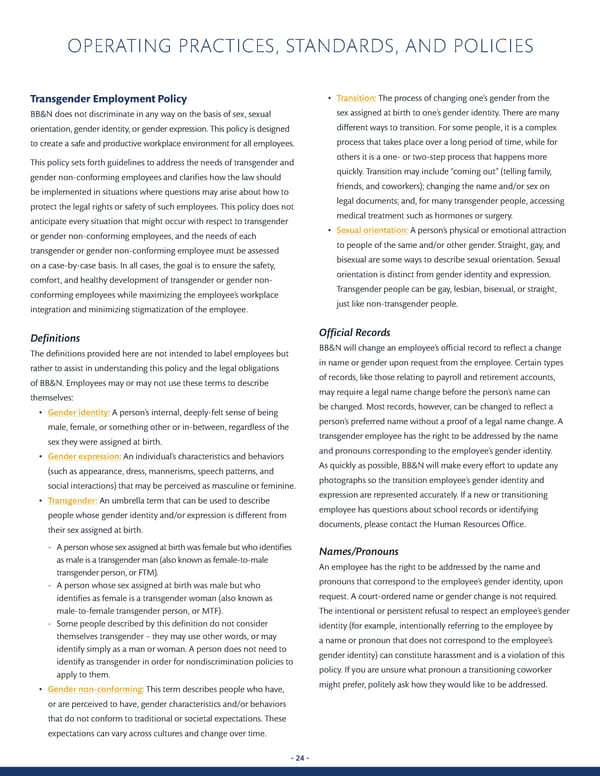OPERATING PRACTICES, STANDARDS, AND POLICIES Transgender Employment Policy • Transition: The process of changing one’s gender from the BB&N does not discriminate in any way on the basis of sex, sexual sex assigned at birth to one’s gender identity. There are many orientation, gender identity, or gender expression. This policy is designed di昀昀erent ways to transition. For some people, it is a complex to create a safe and productive workplace environment for all employees. process that takes place over a long period of time, while for This policy sets forth guidelines to address the needs of transgender and others it is a one- or two-step process that happens more gender non-conforming employees and clari昀椀es how the law should quickly. Transition may include “coming out” (telling family, be implemented in situations where questions may arise about how to friends, and coworkers); changing the name and/or sex on protect the legal rights or safety of such employees. This policy does not legal documents; and, for many transgender people, accessing anticipate every situation that might occur with respect to transgender medical treatment such as hormones or surgery. or gender non-conforming employees, and the needs of each • Sexual orientation: A person’s physical or emotional attraction transgender or gender non-conforming employee must be assessed to people of the same and/or other gender. Straight, gay, and on a case-by-case basis. In all cases, the goal is to ensure the safety, bisexual are some ways to describe sexual orientation. Sexual comfort, and healthy development of transgender or gender non- orientation is distinct from gender identity and expression. conforming employees while maximizing the employee’s workplace Transgender people can be gay, lesbian, bisexual, or straight, integration and minimizing stigmatization of the employee. just like non-transgender people. De昀椀nitions O昀케cial Records The de昀椀nitions provided here are not intended to label employees but BB&N will change an employee’s o昀케cial record to re昀氀ect a change rather to assist in understanding this policy and the legal obligations in name or gender upon request from the employee. Certain types of BB&N. Employees may or may not use these terms to describe of records, like those relating to payroll and retirement accounts, themselves: may require a legal name change before the person’s name can • Gender identity: A person’s internal, deeply-felt sense of being be changed. Most records, however, can be changed to re昀氀ect a male, female, or something other or in-between, regardless of the person’s preferred name without a proof of a legal name change. A sex they were assigned at birth. transgender employee has the right to be addressed by the name • Gender expression: An individual’s characteristics and behaviors and pronouns corresponding to the employee’s gender identity. (such as appearance, dress, mannerisms, speech patterns, and As quickly as possible, BB&N will make every e昀昀ort to update any social interactions) that may be perceived as masculine or feminine. photographs so the transition employee’s gender identity and • Transgender: An umbrella term that can be used to describe expression are represented accurately. If a new or transitioning people whose gender identity and/or expression is di昀昀erent from employee has questions about school records or identifying their sex assigned at birth. documents, please contact the Human Resources O昀케ce. - A person whose sex assigned at birth was female but who identi昀椀es Names/Pronouns as male is a transgender man (also known as female-to-male An employee has the right to be addressed by the name and transgender person, or FTM). - A person whose sex assigned at birth was male but who pronouns that correspond to the employee’s gender identity, upon identi昀椀es as female is a transgender woman (also known as request. A court-ordered name or gender change is not required. male-to-female transgender person, or MTF). The intentional or persistent refusal to respect an employee’s gender - Some people described by this de昀椀nition do not consider identity (for example, intentionally referring to the employee by themselves transgender – they may use other words, or may a name or pronoun that does not correspond to the employee’s identify simply as a man or woman. A person does not need to gender identity) can constitute harassment and is a violation of this identify as transgender in order for nondiscrimination policies to apply to them. policy. If you are unsure what pronoun a transitioning coworker • Gender non-conforming: This term describes people who have, might prefer, politely ask how they would like to be addressed. or are perceived to have, gender characteristics and/or behaviors that do not conform to traditional or societal expectations. These expectations can vary across cultures and change over time. - 24 -
 All-School Employee Handbook AY 24-25 Page 23 Page 25
All-School Employee Handbook AY 24-25 Page 23 Page 25